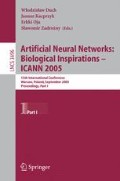Abstract
In this paper we introduce feedback based associative learning in self-organized learning arrays (SOLAR). SOLAR structures are hierarchically organized and have the ability to classify patterns in a network of sparsely connected neurons. These neurons may define their own functions and select their interconnections locally, thus satisfying some of the requirements for biologically plausible intelligent structures. Feed-forward processing is used to make necessary correlations and learn the input patterns. Associations between neuron inputs are used to generate feedback signals. These feedback signals, when propagated to the associated inputs, can establish the expected input values. This can be used for hetero and auto associative learning and pattern recognition.
Access this chapter
Tax calculation will be finalised at checkout
Purchases are for personal use only
Preview
Unable to display preview. Download preview PDF.
References
Rumelhart, D.E., McClelland, J.L., The PDP Research Group: Parallel Distributed Processing. MIT Press, Cambridge (1986)
Hecht-Nielsen, R.: Neurocomputing. Addison-Wesley, Reading (1990)
Kosko, B.: Bidirectional associative memories. IEEE Trans. Syst., Man, Cybern. 18, 49–60 (1988)
Wang, L.: Multi-associative Neural Networks and Their Applications to Learning and Retrieving Complex Spatio-Temporal Sequences. IEEE Trans. Syst., Man, Cybern. 29(1) (February 1999)
Hopfield, J.J.: Neural networks and physical systems with emergent collective computational abilities. Proc. Nat. Acad. Sci. USA 79, 2554–2558 (1982)
Vogel, D., Boos, W.: Sparsely connected, Hebbian networks with strikingly large storage capacities. Neural Networks 4(10), 671–682 (1997)
Vogel, D.: Auto-associative memory produced by disinhibition in a sparsely connected network. Neural Networks 5(11), 897–908 (1998)
Guyon, I., Personnaz, L., Nadal, J.P., Dreyfus, G.: Storage and retrieval of complex sequences in neural networks. Phys. Rev. A 38, 6365–6372 (1988)
Wang, D.L., Yuwono, B.: Anticipation-based temporal pattern generation. IEEE Trans. Syst., Man, Cybern. 25, 615–628 (1995)
Wang, L.: Multi-associative neural networks and their applications to learning and retrieving complex spatio-temporal sequences. IEEE Trans. Syst., Man, Cybern., Part B 29(1), 73–82 (1999)
Starzyk, J.A., Zhu, Z., Liu, T.-H.: Self-Organizing Learning Array. IEEE Trans. on Neural Networks 16(2), 355–363 (2005)
Watts, D.J., Strogatz, S.H.: Collective dynamics of small-world networks. Nature 393, 440–442 (1998)
Loh, W.-Y.: Teaching Assistant Evaluation, June 7 (1997), Available: http://www.stat.wisc.edu/~limt/mach1317.pdf
Fisher, R.A.: Iris Plants Database (July 1988), Available: http://faculty.cs.byu.edu/~cgc/Teaching/CS_478/iris.arff
Andonie, R., Cat¸aron, A.: An Informational Energy LVQ Approach for Feature Ranking. In: Verleysen, M. (ed.) The European Symposium on Artificial Neural Networks (ESANN 2004), Bruges, Belgium, April 28-30, pp. 471–476. D-side publications (2004)
German, B.: Glass Identification Database (September 1987), Available: http://www.ailab.si/orange/doc/datasets/glass.htm
Author information
Authors and Affiliations
Editor information
Editors and Affiliations
Rights and permissions
Copyright information
© 2005 Springer-Verlag Berlin Heidelberg
About this paper
Cite this paper
Starzyk, J.A., Zhu, Z., Li, Y. (2005). Associative Learning in Hierarchical Self Organizing Learning Arrays. In: Duch, W., Kacprzyk, J., Oja, E., Zadrożny, S. (eds) Artificial Neural Networks: Biological Inspirations – ICANN 2005. ICANN 2005. Lecture Notes in Computer Science, vol 3696. Springer, Berlin, Heidelberg. https://doi.org/10.1007/11550822_15
Download citation
DOI: https://doi.org/10.1007/11550822_15
Publisher Name: Springer, Berlin, Heidelberg
Print ISBN: 978-3-540-28752-0
Online ISBN: 978-3-540-28754-4
eBook Packages: Computer ScienceComputer Science (R0)

